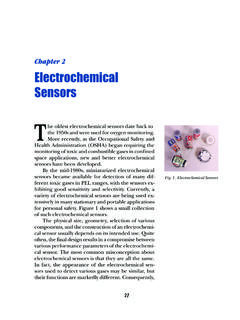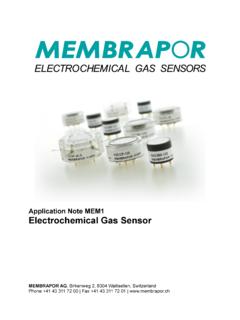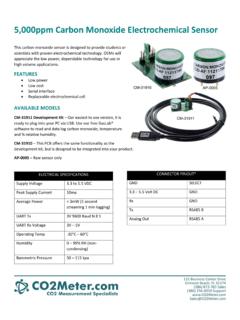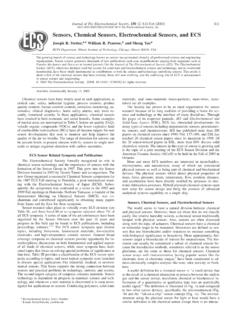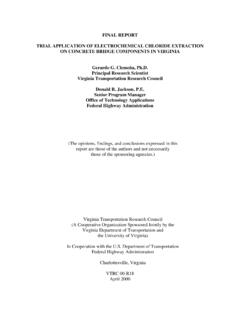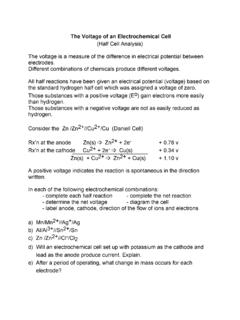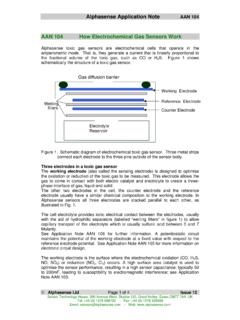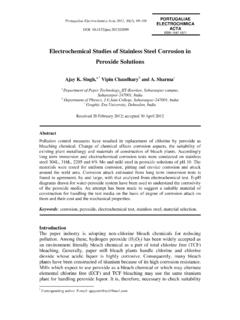Transcription of Variable Mott-Schottky plots acquisition by ...
1 J. Solid State Electrochem. 2005 DOI The original publication is available at This preprint was downloaded from Variable Mott-Schottky plots acquisition by potentiodynamic electrochemical impedance spectroscopy Alexander S. Bondarenko and Genady A. Ragoisha * Physico-Chemical Research Institute, Belarusian State University, 220050 Minsk, Belarus Abstract Potentiodynamic electrochemical impedance spectroscopy provides extraction of potential-dependent space charge layer capacitance from potentiodynamic impedance spectra of nonstationary semiconductor-electrolyte interface. The new technique has been applied for acquisition of Mott-Schottky plots of cathodically treated TiO2 anodic films. Cathodic treatment in 1 M H2SO4 increases donor density and flat band potential of TiO2. Freshly doped films show hysteresis in the space charge layer capacitance in cyclic potential scans. The subsequent cycling eliminates the hysteresis but preserves the greater part of the doping effect.
2 Keywords: potentiodynamic electrochemical impedance spectroscopy, multivariate electrochemical response analysis, semiconductor-electrolyte interface, Mott-Schottky plots Introduction acquisition of Mott-Schottky plots is a usual way for semiconductor materials electrochemical characterisation [1-3]. Mott-Schottky plot (inverse square of space charge layer capacitance, Csc-2, versus semiconductor electrode potential E) gives doping density by slope of the straight line and flatband potential by intercept. electrochemical determination of these parameters is simple when energy band edges are pinned at the surface and ac response of space charge layer capacitance can be separated in frequency range from other interfacial structures and processes, which is a usual case for stationary ideally polarisable semiconductor-electrolyte interface. Complications come with surface states and Faradaic processes that require frequency response analysis by impedance spectroscopy for extraction of space charge layer capacitance from the total ac response [3-8].
3 Common impedance spectroscopy is a stationary technique and this makes the problem, since complex semiconductor-electrolyte interfaces are often nonstationary, especially in microheterogeneous systems where the advantages of electrochemical characterisation could be exceptionally important. New opportunities for nonstationary interface frequency response analysis emerge from potentiodynamic electrochemical impedance spectroscopy (PDEIS) [9,10]. PDEIS decomposes ac responses of different interfacial processes and structures in electrode potential scan and this enables acquisition of Csc-2(E) plots in a single experiment. Analysis of potentiodynamic impedance spectra provided separation of overlapping double layer response and responses of nonstationary upd [11,12] and simultaneous anion adsorption [9,13]. This communication reports PDEIS application for nonstationary TiO2 anodic film Mott-Schottky plots acquisition in system with Variable donor density attributed to electrochemical proton intercalation and ejection.
4 Cathodic treatment of passive anodic films on titanium is known to increase donor density by proton intercalation [14]. Though the proton intercalation effect on semiconductor properties was known to electrochemists, the nonstationary processes stayed on the by-way of semiconductor electrochemistry because of complexity of nonstationary systems frequency response analysis with common techniques. With potentiodynamic frequency response analysis, phenomena of this kind become easily traceable. Presented at the 4th Baltic Conference on Electrochemistry, Greifswald, 13-16 March 2005 * E-mail: (Genady Ragoisha) 2 Experimental Potentiodynamic electrochemical impedance spectrometer is a computer program that acquires electrochemical system frequency response with virtual instruments. Variable interface is probed by streams of low-amplitude wavelets in the potential scan by means of a common potentiostat used as actuator [9,10].
5 Built-in analyser solves inverse problem, and gives equivalent electric circuit (EEC) parameters dependences on the electrode potential [9,15]. Thus, the variation of space charge layer capacitance with electrode potential is obtained straightforwardly from PDEIS spectrum analysis. Experimental set-up in PDEIS spectra acquisition and analysis was the same as in [9,10]. Variable frequency response was acquired in the form of 3D impedance data in the range from 23 to 877 Hz measured at 20 frequencies as function of the potential in the range between 0 and V (vs. Ag | AgCl | KClsat.). The typical view of the virtual spectrometer interface in the stage of PDEIS spectra acquisition for the cathodically doped anodic TiO2 film is presented in Scheme 1. EEC was obtained from PDEIS spectra with a built-in spectrum analyser as described in [9,15]. The analyser derived the EEC by complex nonlinear least squares fitting to 2D data in constant potential sections of PDEIS spectra; however, the fitting procedures benefited from EEC verification on the potential scale and this was due to the 3D nature of the overall data.
6 Due to variation of different processes contributions to the total ac response, ambiguities of fit that occur in 2D impedance spectra are resolved in PDEIS by examination of questionable circuits behaviour on the potential scale. Correct model gives EEC elements as smooth continuous functions of the potential with 2 below 10-4 and low relative errors for individual elements, while incorrect models can occasionally fit to certain constant potential sections but show unstable behaviour with Variable potential [9]. Thus, additional Variable in the fitting compensates for a short frequency range in impedance spectra. The attitude to the frequency range is different in PDEIS and in stationary EIS [9]. Stationary EIS uses wide frequency ranges in order to obtain complete EEC and enable Kramers-Kronig analysis, while PDEIS intentionally narrows the range to those frequencies where the desired component of ac response can be efficiently separated from responses of overlapping EEC elements.
7 The most informative range for interfacial constituent responses separation is usually from several 10 1,000 Hertz. Space charge layer capacitance is often easily separated from double layer and Faradaic responses in single frequency slightly above this range. However, in anodic TiO2 films, relaxation processes in the space charge layer and on the interface give additional active and reactive EEC elements, as we will show below; therefore the nonstationary frequency response analysis was required for Csc response separation. We would like to note that the EECs derived from responses in short frequency ranges might differ from EECs in wide frequency range in possible lack of elements that respond outside the range tested and even in character of the derived elements, capacities that behave ideally in short frequency range are not necessarily frequency independent in wide frequency range, models of diffusion may also change with the frequency range, etc.
8 In general, deviations from idealised models of constituent electrochemical responses increase with the frequency range; therefore the usage of narrow frequency range is wholesome for nonstationary system frequency response analysis. In PDEIS spectra analysis, the possible absence of elements that might appear in stationary impedance analysis is the advantage rather than a drawback. EEC elements that do not contribute to the response are redundant; they just increase the number of parameters and complicate inverse problem solution. Titanium electrodes were oxidised anodically by applying a voltage up to 80 V for 10 min in 1M H2SO4. The anodic film was doped by applying a cathodic treatment for 2 min at V. After the cathodic treatment the electrodes were kept for 20 s at 0 V and then a series of PDEIS spectra was recorded in cyclic potential scans between 0 and V. Figs. 1 and 2 show examples of constant potential sections of the PDEIS spectra and dependencies of real and imaginary impedance on electrode potential in the first cycle after doping.
9 The analysis of PDEIS data gave the EEC shown in with 2 of the fit around 10-5 and smooth continuous dependence of EEC parameters on the 3 potential in the whole potential range. The equivalent circuit contains two capacitances (the capacitance of the space charge layer Csc and the double layer capacitance Cdl). Csc is connected in parallel with a series of an active resistance Rc and Warburg element W. Cdl and Csc have exchanged their more common places, due to absence of Faradaic current (correspondingly, there was no Faradaic impedance in parallel with Cdl) and nonstationary processes in the space charge layer that produced a branch similar to Faradaic impedance in parallel with Csc. This additional RW contribution was almost negligible in undoped film but became considerable after the cathodic treatment. The accuracy of individual parameters determination was characterised and controlled in the EEC fit by 2 sensitivity to the corresponding parameter variation near the global minimum, e.
10 G. 10% variation of 2 corresponded to less then variation of Csc, which was sufficient for reliable decomposition. We acquired frequency response in the excessive mode with long-duration potential steps for precise decomposition of EEC elements. The height of each step was 5 mV and the length was s. The ac probing signal amplitude was 10 mV, so that the resulting dependences of the parameters on the potential were quasi continuous. Using higher than usual potential steps was acceptable in this case, due to almost complete absence of Faradaic current in the potential range tested. Five millivolt steps provided relatively high overall scan rate ( mV/s) with long potential steps. The main part of each period was used for frequency response probing with streams of wavelets and real-time analysis of the response, while a very small part of the period was given for updating data on a computer screen (data acquisition , processing, control and real-time visualisation of the Variable response were implemented by a single processor the CPU of a personal computer).
